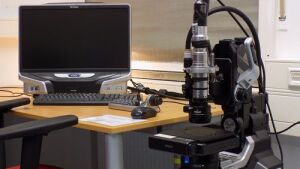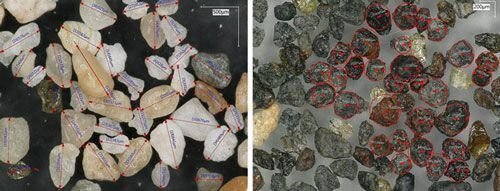Keyence digital microscope
Keyence CHX-8000
Image: C. HeubeckThe Keyence CHX-8000: a digital microscope.
Instead of light from an illuminated object being transmitted through objectives and eyepieces into the eye, where it is processed by specialized cells, the light rays are captured by the objective, registered on a CCD chip in a camera, stored and displayed on a screen. The device works in incident and transmitted light with several continuously adjustable objectives and has multiple illumination options (LED ring). The polarization, e.g. for the documentation of thin sections, is unfortunately only adequate.
Because the information generated is digital, it can be easily processed using conventional image processing methods, including pattern recognition and pixel analysis. Because the chip detects whether a pixel is sharp by comparing it to its neighbors, the computer uses the stacking technique (several hundred images, each with 1 µm variation in distance focus) to select only the sharp pixels from these to form a single depth-focused image. This 3-D information is also used to compile surface information; 2-D profiles and simple topographic relief information can be constructed. Brightness and illumination can be adjusted in a versatile and detailed manner for optimal imaging. Digital image analysis techniques (pattern recognition, etc.) are combined in a user-friendly module.
We use the instrument in a variety of ways for research, e.g., to detect and document structures on a microscopic scale, for rapid measurement and statistical characterization of grains and crystals (loose or composite), for project work, and in teaching in the MSc module "Sedimentary Petrography."
Korngrößenmessungen
Image: C. HeubeckHere is the reservation calendar.External link

